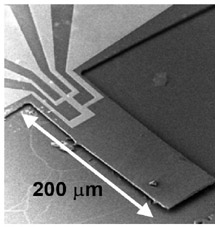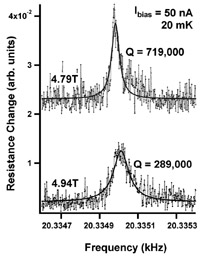1Physical Science Laboratory, 2University of Tokyo, 3Tohoku University
Novel methods for investigating the electron behavior in low-dimensional
semiconductor structures have been recently developed by integrating these
structures into micro/nanomechanical systems. Using the methods, remarkable
strain effects on transport properties [1] and the electron magnetization
have been studied. We integrated a high mobility two-dimensional electron
system (2DES) in micromechanical cantilevers to study the strain effect
on magnetotransport properties in the quantum Hall regime. In addition
to the remarkable strain effect at the localized-delocalized electronic
state transition, we detected electron-induced internal friction against
the cantilever motion with the help of the high mechanical performance
of the single crystalline cantilever [2].
A 2DES Hall bar with low-temperature mobility of 2.4×106 cm2/Vs was integrated near the clamping point of a 200-µm long and 60-µm
wide cantilever with the thickness of 1.3 µm (Fig.1). Using a piezoelectric
ceramic to drive the cantilever mechanical motion, the induced resistance
change was measured as a function of magnetic field. The obtained ‘magnetopiezoresistance’
curve showed a strongly enhanced piezoresistance at the transition between
the localized and delocalized electronic states. We obtained a maximum
piezoresistive gauge factor of as much as 25,000 near the ν=4 transition.
We found that the cantilever mechanical motion is affected by friction
exerted by the electron system, demonstrating its availability for studying
the electron energy dissipation. The quality factor of mechanical resonance
strongly depended on the applied magnetic field; the value was about 106 near the localized states but only 3×105 for fully delocalized states, indicating the suppression of electron energy
dissipation by electron localization (Fig. 2). The strong coupling of the
mechanical and electronic degrees of freedom in such integrated structures
provides us with a novel method with which to undertake a detailed study
of electron behavior in low-dimensional semiconductor structures.
This work was partly supported by Japan Society for the Promotion of
Science (JSPS) KAKENHI (16206003).
[1] H. Yamaguchi, et al., Appl. Phys. Lett. 86 (2005) 052106.
[2] H. Yamaguchi, et al., Jpn. J. Appl. Phys. 46 (2007) L658.
 |
 |
|||||
|
|